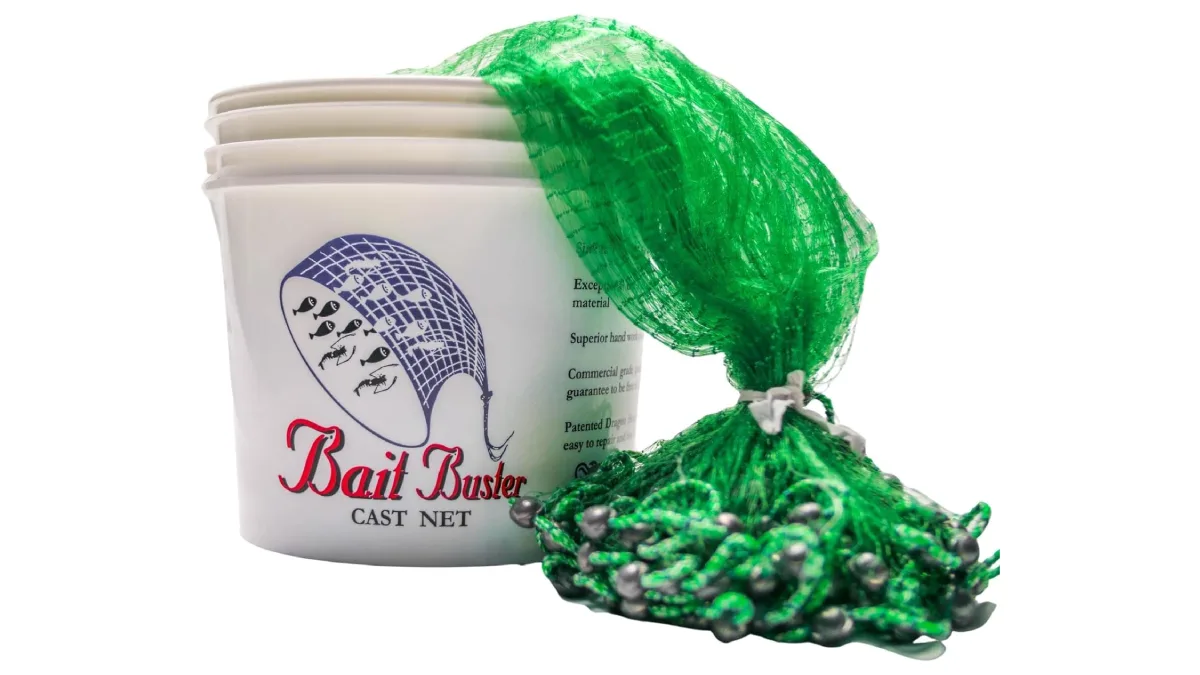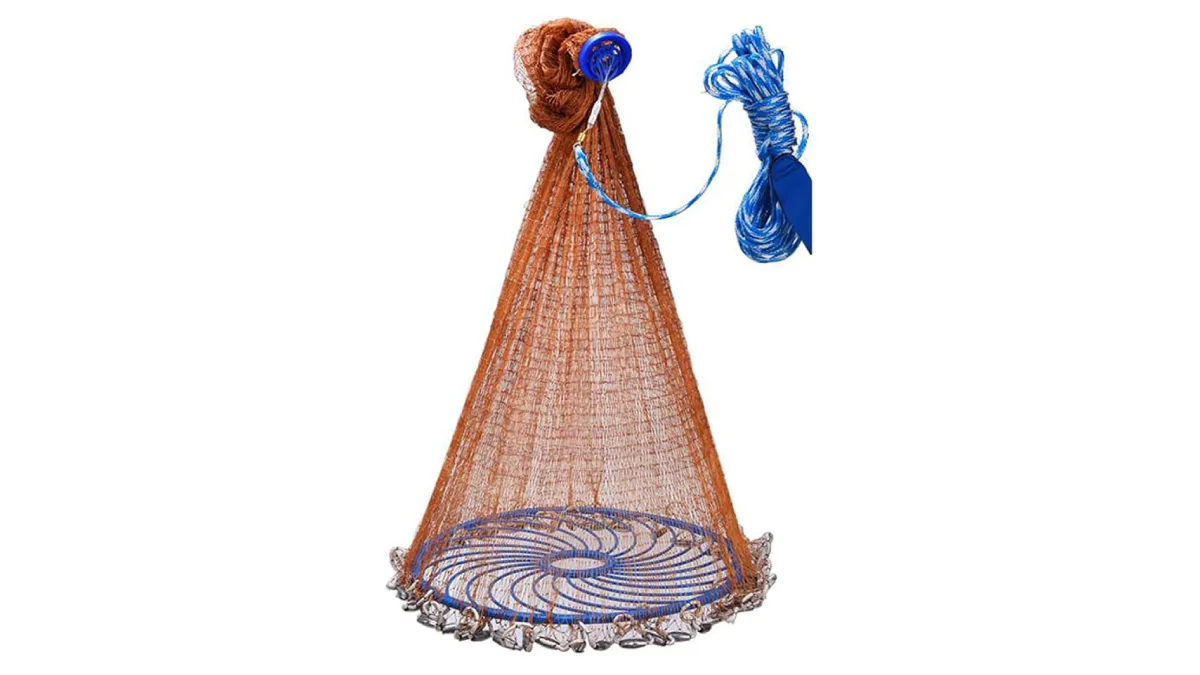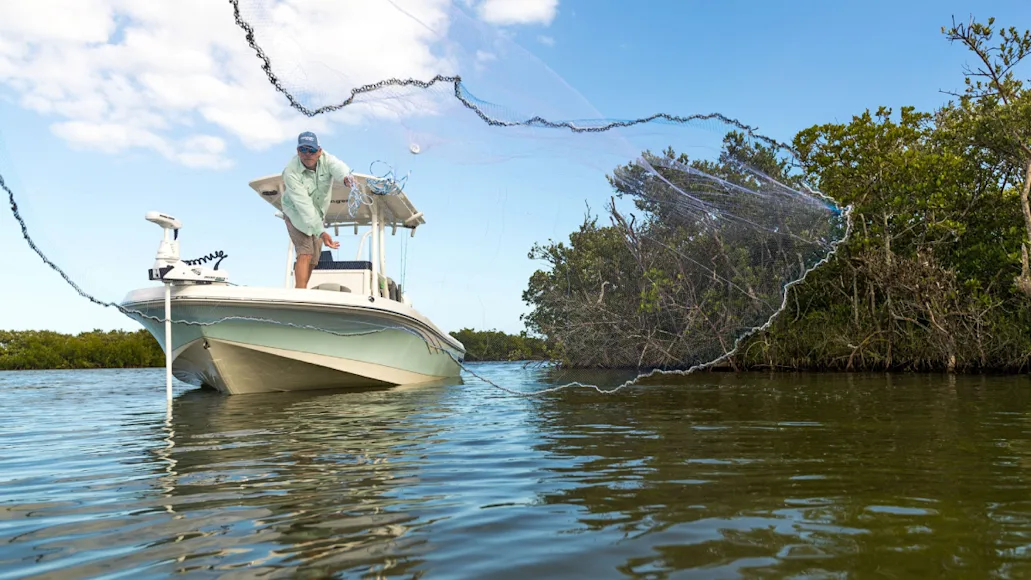_We may earn revenue from the products available on this page and participate in affiliate programs. Learn more ›
_
Best Overall

Bait Buster Cast Net
Best for Large Bait

Betts Mullet Cast Net
Best for Smaller Bait and Shrimp

Betts Super Pro Cast Net
An efficient and effective means of catching fish, a cast net is a circular net with a string of weights around the edge and a hand line in the center. Like the name suggests, it works by throwing the net into the water where it lands over unsuspecting fish. The angler throws the net into the air and the circular weights cause the net to open before hitting the water. Once in the water, the leadline sinks the net to cover the target fish or shrimp. When the net hits the bottom, the angler pulls the handline, closing the bottom of the net, and retrieving the catch.
Cast nets have hardly changed for thousands of years. And a lot of us still use them, as they’re easy to operate for beginners and extremely effective at catching smaller fish in shallow water. We used our years of experience saltwater and freshwater fishing to narrow down the best cast nets for any angler.
The Best Cast Nets
Best Overall: Bait Buster Professional Grade Cast Net
Best for Beginners: Topineer Flying Disc Magic Hand Cast Net
Best Budget: Goture American Saltwater Fishing Cast Net
Best for Large Bait: Betts Mullet Cast Net
Best for Smaller Bait and Shrimp: Betts Super Pro Cast Net
Best Overall: Bait Buster Cast Net
Best Overall

Specs
Weight: 1.5-pound per foot
Dimensions: 6-foot radius; ⅜-inch mesh
Materials: Monofilament
Pros
Fast sink rate thanks to 1.5 pound per foot of weight
Green net doesn’t spook fish
Green net doesn’t spook fish
Cons
Expensive
Professional anglers demand excellent performance from their cast net. Pro anglers design Bait Buster nets to throw easily and catch more fish.
Starting with super-soft, hand-tied monofilament mesh, the net opens quickly with less effort. To sink quickly, the Bait Buster uses round sinkers with 1.5-pounds of lead per foot. Once on the bottom, filled with fish, 100-pound test brail lines, and a heavy-duty floating hand line, close the net and retrieve the catch.
Bait Buster nets are designed by fishermen with details that make the nets reliable. For example, the lead weights are crimped to the edge of the net to keep them in place. And, Bait Buster’s patented Dragon Head swivel makes it easy to replace brail lines.
Solid construction and quality materials make the Bait Buster a favorite for anglers who depend on their cast net for a paycheck. The Bait Buster may be the most expensive in our review, but catching more bait in less time pays off in the end.
Best for Beginners: Topineer Flying Disc Magic Hand Cast Net
Best for Beginners

Specs
Weight: 1-pound per foot radius
Dimensions: 7-foot radius; ¾-inch mesh
Throwing disk
Pros
Tyre nylon mesh is softer than monofilament
Smaller sinkers tied closer together for faster sink rate
Easier to throw than most
Cons
Lead sinkers
Throwing a cast net is the hardest part of catching bait. It takes time and practice to master the technique. To make the process easier, the Topineer Flying Disc Magic Hand includes a special plastic disk that ensures the net opens perfectly every time. Making this net the best cast net for a beginner.
The plastic disc takes a lot of the learning curve out of throwing a cast net. While you’re not likely to start throwing perfect circles on your first outing, this specially designed implement will quickly get you on the right track.
At 14-feet diameter, the net covers a lot of water for the best chance of catching fish. Two-centimeter mesh is a great all-around size for a wide variety of bait with one pound of lead per foot to sink quickly.
Tyre nylon mesh is soft to open quickly and easily and more durable than monofilament. The Topineer net comes with a handy carry case that allows the net to dry, which will help the net last.
Best Budget: Goture American Saltwater Fishing Cast Ne

Specs
Weight: 1-pound per foot
Dimensions: 6-foot radius; ⅜-inch mesh
Materials: Copolymer monofilament mesh, plastic-coated iron weights
Pros
Hand-tied mesh
Padded neoprene wrist loop
Plastic-coated iron weights
Cons
One pound per foot sinks slowly
Goture’s American Saltwater Fishing Cast Net is the best budget cast net, offering a wide range of uses. Starting with a six-foot radius makes the net easier to throw, while the 12-foot diameter covers a lot of water. At one pound of weight per foot of diameter, the net is best for shallow water. The net’s ⅜-inch mesh is perfect for capturing medium to large bait.
Small details make a big difference. The plastic-coated iron sinkers are corrosion resistant, environmentally friendly, and won’t mark the boat deck. The neoprene wrist loop is comfortable and secure to keep the handline attached to the angler. The hand-tied, copolymer monofilament mesh is soft to open easily and tough enough to survive years of abuse. If you are going to buy one net and save some money, a six-foot, ⅜-inch mesh Goture’s American Saltwater Fishing Cast Net is a good start.
Best for Large Bait: Betts Mullet Cast Net
Best for Large Bait

Specs
Weight: 1.25 pounds per foot balances sink rate with performance
Dimensions: 7-foot radius; 1-inch mesh
Materials: Bonded monofilament and treated leadline
Pros
Knots double tied and epoxy-bonded
Braided leadlines with hardcore won’t kink
Designed for less wind resistance
Cons
Expensive
Look in almost any serious angler’s garage, and you’ll find a Bett’s cast net. For decades, sturdy construction and smart features at a great price have made Bett’s cast nets the most popular choice for beginners to pros.
Bett’s Pro Series nets are designed to take abuse. Cast nets often come into contact with unseen underwater obstructions, but this one is durable enough to resist damage. Heavy brail lines, reinforced leadline, and bonded knots make the Pro Series a great choice for years of reliable performance.
The Pro Series features an aerodynamic shape to open quickly and fly far with less effort. The seven-foot model comes in a one-inch mesh, with 1.25-pounds of weight per foot. In the water, the perfectly balanced lead line and light mesh work together to capture fast-moving baits. Large baits like pogies, herring, and scad don’t stand a chance. And the heavy-duty construction easily contains a hefty haul of the big baits.
Best for Smaller Bait and Shrimp: Betts Super Pro Cast Net
Best for Smaller Bait and Shrimp

Specs
Weight: 1.3 pounds per foot
Dimensions 8-foot radius; ¼-inch mesh
Materials: Monofilament
Pros
Designed by a famous fisherman
Additional weight sinks faster
Double selvage and bonded thread for a stronger leadline
Cons
Heavy-duty construction slows sink rate
Catching small bait and shrimp is serious business. The challenge is using a net with tight mesh to trap smaller bait and sink quickly so the fish can’t escape. Bett’s Super Pro cast nets have balanced this challenge with a net designed to last for years.
The ¼-inch mesh of the 24-8 Super Pro will trap the smallest bait and shrimp, thanks to the heavier than typical 1.3 pounds of weight per foot that gets the net down fast. Even speedsters like pilchards and mantis shrimp will have difficulty evading the net as it heads for the bottom. Double selvage and bonded line at the leadline avoid tearing if the net gets tangled when it gets there. A ⅜-inch handline is strong enough to retrieve a full net without fail.
Cast nets can be tough to throw. Betts wanted to make this one easy to use. They employed a professional fisherman to design this one to open quickly and completely with less effort.
How We Evaluated Cast Nets
There are some important terms to understand before choosing a cast net. A cast net is measured by the net’s radius. For example, a six-foot cast net will have a 12-foot diameter. The mesh size refers to the holes in the net. The horn is the ring at the center of the cast net. The leadline consists of sinkers sewn into the outer edge of the net. Another important consideration is the pounds of weight per foot of diameter. A heavier net, like 1.5 pounds per foot, will sink faster than a lighter one-pound per foot net.
The best cast nets are made of soft, hand-tied mesh netting. The lead line is braided polypropylene rope with weights securely attached. Brail lines running from the handline to the lead line should be heavy-duty monofilament
. The best nets add features like coated lead that doesn’t mark the boat deck, a heavy duty swivel at the neck, and an aerodynamic design to fly through the air and open completely.
Cast nets in this test were evaluated on the quality of construction and materials, with an eye on the following:
Netting: Is the net material soft and pliable enough to catch bait without damaging it?
Brail Lines: Are these constructed of heavy-duty materials that can withstand the weight of a full net?
Weight: Does the net have enough weight to catch the bait pursued?
Lead Lines: Are the weights attached securely enough to withstand thousands of throws?
Durability: Cast nets are often used in saltwater. Can the materials used stand up to this harsh environment?
Ease of Use: Do these nets open reliably, without undue effort?
The nets in this review also feature tough construction to withstand years of snags and fish fins. Features like double strength netting, crimped weights, and hand-tied knots pay off with a stronger, more reliable cast net.
Cast Net Buying Guide
Before buying a cast net, it is important to consider what bait you will target and the depth of the water. For deeper water, a heavier lead line will reach the bottom faster. On the other hand, a lighter net is easier to throw and more appropriate for shallows.

Mesh Size
Choosing the mesh size is based on the size of the bait you will target. Remember, the bait should be scooped up in the net, not snagged in the mesh. Plan to use mesh that is smaller than the target bait to avoid damaging the bait and make unloading the net faster and easier.
A larger mesh size will sink faster to cover up the bait before it can escape. Use a larger mesh in deeper water for larger bait.
Radius
Of course, the most important consideration is the net’s radius. A net with a larger diameter will cover more water to capture more fish. However, a net with a radius larger than six-foot requires two hands and half your body to throw. A smaller net can be thrown with two hands.
Also, a smaller net is better for catching bait in narrow creeks or extremely shallow water. Wade anglers and kayak anglers prefer a smaller net that is easier to throw.
Throwing
To throw the net, the angler bunches up the net material and coils the hand line. Then, by twisting his body and swinging their arms, they throw the net into the air, where it opens into a wide circle before landing on the water.
How big a net you can throw relies greatly on your proficiency, though body size does come into play. Even those of smaller stature can learn to throw large nets, but if you are just starting out, you will be better served with a smaller one.
Hauling
As the net sinks, it captures fish inside. When the net hits bottom, the angler pulls the handline to close the bottom of the net and trap the fish. Then, using the handline, the angler retrieves the net and their catch. A full net can be very heavy, so make sure you don’t bite off more than you can chew by using too large of a net.
FAQs
Q: How much does a cast net cost?
For many anglers, purchasing a cast net comes down to how much it costs. Cast nets range in price from $20 to over $200. Even two nets with the same size and weight can have a different price tag. The difference comes down to construction and materials. A more expensive net will have stronger components and a sturdier build than less expensive nets. Not only will the higher-priced net last longer, but better-quality mesh and lines make it easier to throw and more likely to catch fish. If you’re not planning to use a cast net often, then a cheaper model may be sufficient. But, if you want a reliable net that will produce bait and fish for years, then you will have to pay for it.
Q: What is the best size cast net to buy?
Choose the size of the cast net based on the size of the bait and the depth of the water. A larger radius net with larger mesh and heavier lead will work better for large bait in deep water. To catch smaller bait in shallow water, a smaller diameter net with less weight is easier to throw. Serious anglers have several cast nets to target fish in a variety of conditions.
Q: What makes a good cast net?
A good cast net is built of quality materials and components with sturdy construction for years of use. Look for heavy-duty yet soft and flexible mesh, handline, and brail lines. The weights should be firmly secured to the leadline, and the best models use coated weights that won’t mark the boat deck. A net with multiple panels of hand-tied mesh opens easily and tends to cover the most area.
Q: What is the easiest cast net to throw?
Throwing a cast net takes patience and practice. Of course, a smaller cast net is easier to throw, but it covers less water and traps fewer fish. The most important thing is to find the right size and weight cast net for the fish you plan to target. Then, look for the highest quality net with the best materials and smart construction to make throwing it easier and more efficient.
Q: What is the best cast net?
The best cast net is easy to throw and deadly in the water. Bait Buster’s Professional Series
performs best in both categories. Constructed of six mesh panels, heavy-duty brail lines, and a reliable Dragon Head swivel, the Professional Series is easy to throw and retrieve. Heavy-duty construction and quality materials keep the cast net fishing for years of perfect pancakes.
Why Trust Us
For more than 125 years, Field & Stream has been providing readers with honest and authentic coverage of outdoor gear. Our writers and editors eat, sleep, and breathe the outdoors, and that passion comes through in our product reviews. You can count on F&S to keep you up to date on the best new gear. And when we write about a product—whether it’s a bass lure or a backpack—we cover the good and the bad, so you know exactly what to expect before you decide to make a purchase.






